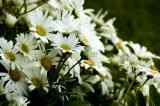Montauk Daisy - Chrysanthemum Nipponicum


Two years ago in October I was taking a drive in the countryside in Western New York when I passed a farm that had an enormous display of white flowers for sale. I made a U-turn and stopped. I had never seen these flowers before – they were not exactly chrysanthemums and not exactly daisies. Thus I was introduced to the Montauk Daisy, named after Montauk, New York, which is a city on Long Island.
They were beautiful, looked very sturdy and best of all they were $3 for a gallon size pot. I purchased 5 of them and placed them in various parts of my garden not really knowing what to expect.
Well, the outcome has been amazing. They have grown about 3 feet high and maybe 4-5 wide
As its current Latin name suggests, this daisy originated in Japan (Nippon). This plant is native to the island's coastal area. Montauk daisies like well-drained sites with full sun. They are rated for growing in zones 6 to 10, which means that most temperate zone gardeners can enjoy this flower.
As its current Latin name suggests, this daisy originated in Japan (Nippon). This plant is native to the island's coastal area. Montauk daisies like well-drained sites with full sun. They are rated for growing in zones 6 to 10, which means that most temperate zone gardeners can enjoy this flower.

During spring and summer the he Montauk daisy will spend most of the growing season as a pleasant leafy filler in your flowerbeds. Foliage is deep green, with a slightly leathery texture, the stems grow from hardy roots into a tall, bushy "sub shrub."
The three-inch leaves are toothed and oblong, similar to the Shasta daisy and chrysanthemum cousins. In early October, dozens of classic white, yellow-centered blooms open and adorn the plant until hard frost (28 degrees F).
They are deer-resisting, butterfly attracting.
The three-inch leaves are toothed and oblong, similar to the Shasta daisy and chrysanthemum cousins. In early October, dozens of classic white, yellow-centered blooms open and adorn the plant until hard frost (28 degrees F).
They are deer-resisting, butterfly attracting.

I have learned that because the Montauk daisies begins to green in the flower bed a month or two before the time to plant summer annuals, croci, pansies, daffodils or early tulips can be planted around the plant to take advantage of space later to be shaded by the growing stems.
They do need pruning and pinching off new stem growth in the spring and early summer should control their growth. The rule of thumb for the Montauk daisy is 'cut it in half on the first of June and again on the first of December.
The origin of this daisy: It was named Nipponanthemum, which roughly translated means Japanese flower. In the 1860s, a Russian botanist, Carl Maximowicz, brought the Nippon Daisy to his botanical garden in St. Petersburg. He distributed many of these plants around the world so that more people could study them and appreciate their beauty. The Nippon Daisy flourished well on Long Island and is now known in the United States as the Montauk Daisy.
The blooms of the Montauk Daisy last for a long time. They are also great as cut flowers because they have tall stems that are quite strong.
More on this flower in my next posting.








